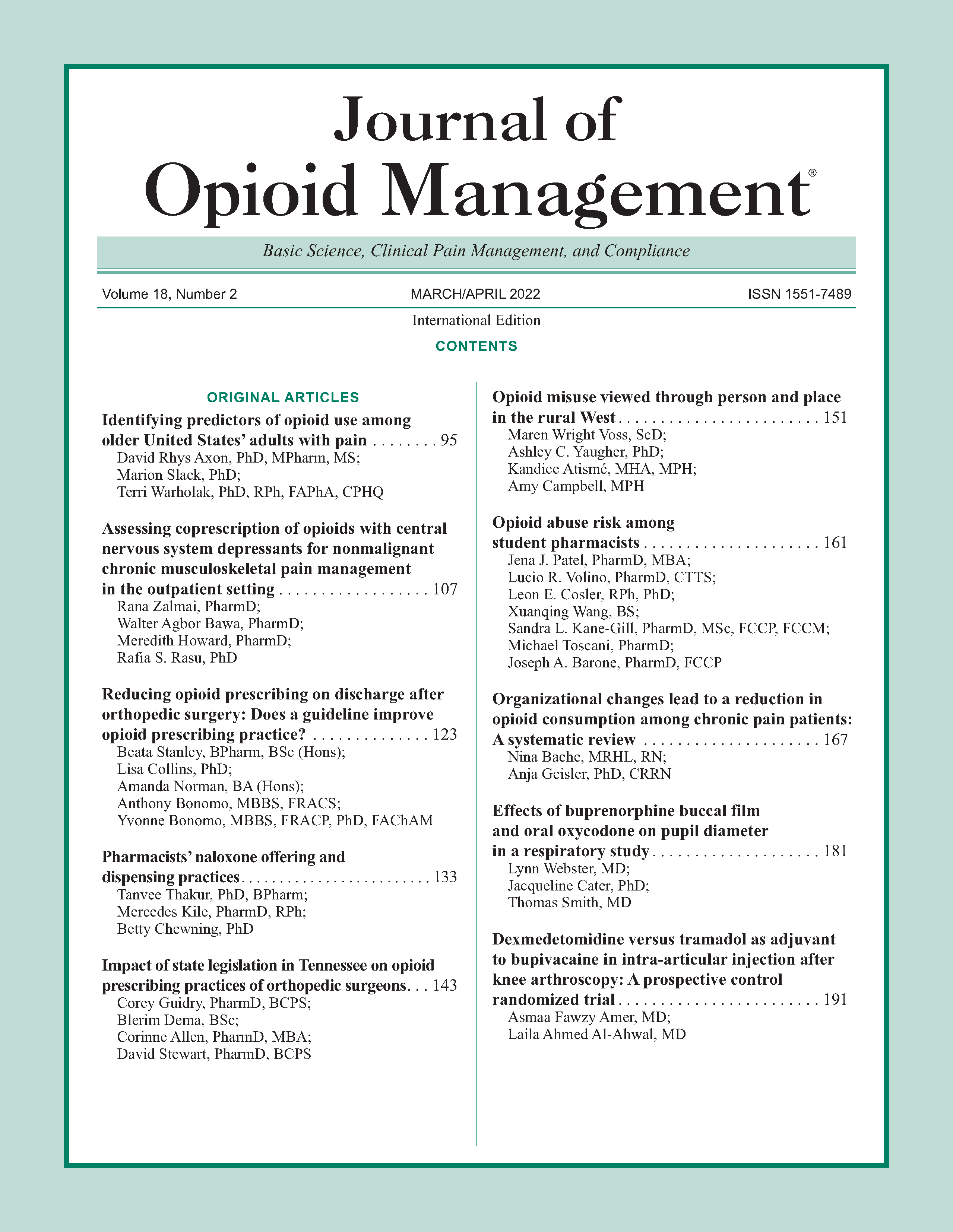Reducing opioid prescribing on discharge after orthopedic surgery: Does a guideline improve opioid prescribing practice?
DOI:
https://doi.org/10.5055/jom.2022.0702Keywords:
analgesia, discharge, guideline, opioids, opioid weaning plan, orthopedic, surgeryAbstract
Aim: To investigate adherence to discharge advice in a prescription opioid prescribing guideline (GL) post-orthopedic surgery.
Methods: The guideline in draft form was introduced in February 2018. To assess longer-term adherence to discharge advice and to understand which components of that advice were adhered to, regular audits of discharge prescribing were performed after formal GL launch in February 2019, a year after the draft of the GL had been available. The post-GL audit was conducted for three months (March to May 2019) and results reviewed. When these audit results showed a need for improvement in prescribing practice, a 1-month education “booster” named prescription opioid practice improvement safe opioid supply (POPI SOS) took place. Audits for a further 3 months (July to Sept 2019) were then carried out to ascertain whether the additional effort improved adherence to the guideline.
Results: On average, adherence to all elements of the guideline was low at only 23.1 percent at 12 months post-draft GL and 1 month after its formal launch. After POPI SOS, a statistically significant improvement was achieved with an average increase in adherence to 52.5 percent (ρ < 0.001). Greatest improvement was seen in the percentage of patients discharged with an opioid plan included in the discharge summary, increasing from 35.8 to 77.7 percent (ρ < 0.001). The second significant improvement observed was in the supply of opioids being limited to four days or less, an increase from 38.1 to 61.9 percent (ρ < 0.001).
Conclusion: Introduction of the guideline was not sufficient to promote sustained change in practice. Ongoing monitoring and education were required for its implementation. These findings highlight that comprehensive, locally adapted, evidence-based opioid stewardship is needed to increase the safety of patients and the community in relation to opioid therapy.
References
Jena AB, Goldman D, Karaca-Mandic P: Hospital prescribing of opioids to Medicare beneficiaries. JAMA Intern Med. 2016; 176: 990-997.
Katz J: Drug deaths climbing faster than ever. Available at https://www.nytimes.com/interactive/2017/06/05/upshot/opioid-epidemic-drug-overdose-deaths-are-rising-faster-thanever.html. Accessed June 6, 2020.
Barnett ML, Olenski AR, Jena AB: Opioid-prescribing patterns of emergency physicians and risk of long-term use. N Engl J Med. 2017; 376: 663-673.
Chhabra N, Leikin JB: The Joint Commission and the opioid epidemic. JAMA. 2017; 318: 91-92.
Calcaterra SL, Yamashita TE, Min S-J, et al.: Opioid prescribing at hospital discharge contributes to chronic opioid use. J Gen Intern Med. 2016; 31: 478-485.
The Society of Hospital Pharmacists of Australia: Reducing opioid-related harm: A hospital pharmacy landscape paper. Available at https://www.shpa.org.au/resources/reducing-opioidrelated-harm-hospital-pharmacy-landscape-paper-medicines-leadership-forum. Accessed August 10, 2020.
Makary MA, Overton HN, Wang P: Overprescribing is major contributor to opioid crisis. Br Med J. 2017; 359: J4792.
Soffin EM, Lee BH, Kumar KK, et al.: The prescription opioid crisis: Role of the anaesthesiologist in reducing opioid use and misuse. Br J Anaesth. 2019; 122: 198-208.
Howard R, Waljee J, Brummett C, et al.: Reduction in opioid prescribing through evidence-based prescribing guidelines. JAMA Surg. 2018; 153: 285-287.
Overton HN, Hanna MN, Bruhn WE, et al.: Opioid-prescribing guidelines for common surgical procedures: An expert panel consensus. J Am Coll Surg. 2018; 227: 411-418.
Grol R, Grimshaw J: From best evidence to best practice: Effective implementation of change in patients’ care. Lancet. 2003; 362: 1225-1230.
Angelo JL, Wu J, Sirody J, et al.: Reduction in prescribed opioids after general surgery procedures at a public hospital. Am Surg. 2019; 85: 1198-1203.
Stanley B, Norman AF, Collins LJ, et al.: Opioid prescribing in orthopaedic and neurosurgical specialties in a tertiary hospital: A retrospective audit of hospital discharge data. ANZ J Surg. 2018; 88: 1187-1192.
Stanley B, Jackson A, Norman A, et al.: Opioid prescribing improvement in orthopaedic specialty unit in a tertiary hospital: A retrospective audit of hospital discharge data pre- and post-intervention for better opioid prescribing practice. ANZ J Surg. 2019; 89: 1302-1307.
Brandal D, Keller MS, Lee C, et al.: Impact of enhanced recovery after surgery and opioid-free anesthesia on opioid prescriptions at discharge from the hospital: A historical-prospective study. Anesth Analg. 2017; 125: 1784-1792.
Bodenheimer T: The movement for improved quality in health care. N Engl J Med. 1999; 340: 488-492.
Fischer F, Lange K, Klose K, et al.: Barriers and strategies in guideline implementation—A scoping review. Healthcare (Basel). 2016; 4: 36.
Gordon AJ, Harding Jr JD: From education to practice: Addressing opioid misuse through health care provider training: A special issue of substance abuse journal. Subst Abus. 2017; 38: 119-121.
Vratsistas-Curto A, McCluskey A, Schurr K: Use of audit, feedback and education increased guideline implementation in a multidisciplinary stroke unit. BMJ Open. 2017; 6: E000212.
van der Weijden T, Wensing M, Giffel M, et al.: Interventions Aimed at Influencing the Use of Diagnostic Tests. Maastricht: WOK, 2000.
Kidd M, Purves I: Role of information technology. In Silagy CA, Haines A (eds): Evidence Based Practice in Primary Care. London: BMJ Books, 2001.
Walton R, Dovey S, Harvey E, et al.: Computer support for determining drug dose: Systematic review and meta-analysis. BMJ. 1999; 318: 984-990.
Jia P, Zhang L, Chen J, et al.: The effects of clinical decision support systems on medication safety: An overview. PLoS One. 2016; 11: e0167683.
Shah A, Hayes CJ, Martin BC: Characteristics of initial prescription episodes and likelihood of long-term opioid use—United States, 2006–2015. Morb Mortal Wkly Rep 2017; 66: 265-269.
Grilli R, Ramsay C, Minozzi S: Mass media interventions: Effects on health services utilisation. Cochrane Database Syst Rev. 2002: Cd000389.
Published
How to Cite
Issue
Section
License
Copyright 2005-2025, Weston Medical Publishing, LLC and Journal of Opioid Management. All Rights Reserved.











